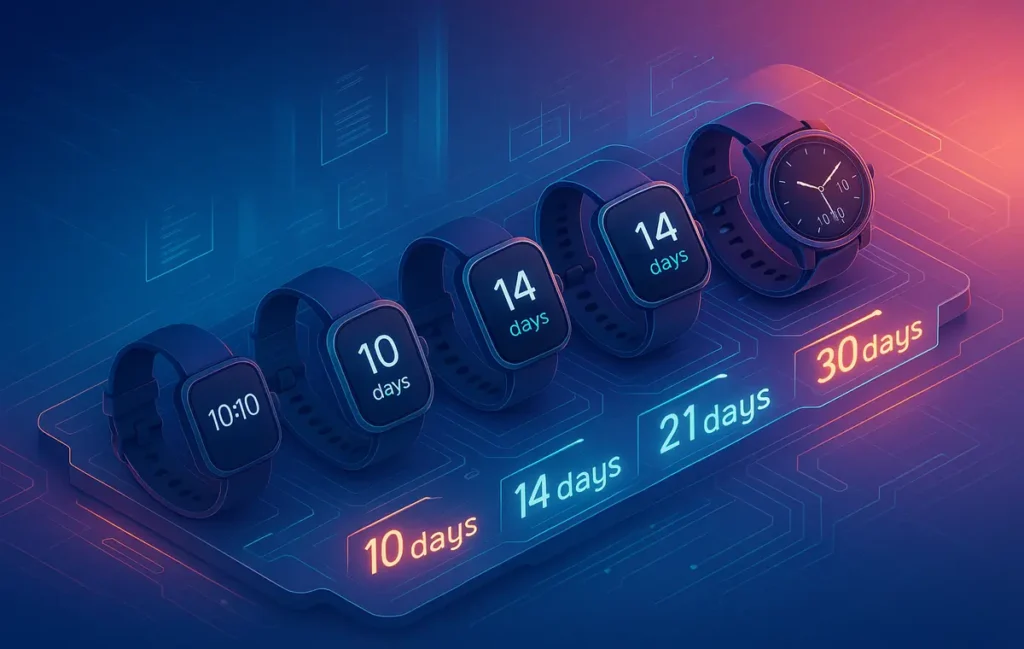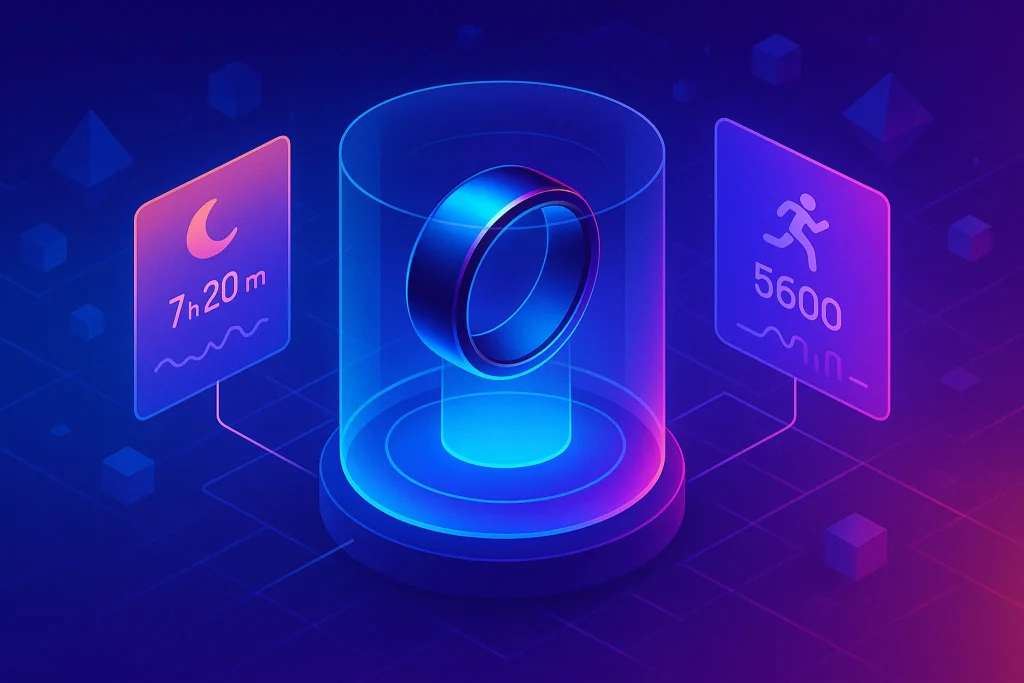🔋 Intro: The Battery Life Problem
Ask any smartwatch user their biggest frustration and chances are, it comes down to charging. The ritual of dropping your watch on a dock every night feels like the price of staying connected, fit, and informed. But in 2025, this equation has shifted. A new generation of smartwatches is changing expectations, with some devices lasting a week, two weeks, or even a full month on a single charge.
This post takes a deep dive into the top smartwatches with long battery life, showing how they stack up for athletes, business travelers, and everyday users. Instead of accepting “daily charging” as the default, you now have real alternatives. And at NerdChips, we believe that when the tech fades into the background and just works, you can focus on living instead of plugging in.
⚡ Why Battery Life Matters More Than Ever
Battery longevity is no longer a side feature—it has become central to the smartwatch experience. For athletes who train outdoors, a watch dying halfway through a marathon or mountain hike is more than an inconvenience—it’s a deal-breaker. Travelers moving across time zones can’t always stop to find a charger, and professionals balancing meetings, flights, and workouts often forget to charge their devices at all.
There’s also a psychological layer: the constant anxiety of whether your device will last through the day. That nagging thought pulls focus from what the watch is supposed to deliver—health tracking, navigation, and smart notifications. Longer battery life removes that friction.
However, there’s always a trade-off. Ultra-bright AMOLED displays, advanced LTE radios, and continuous GPS tracking inevitably consume more energy. The manufacturers leading in battery life have mastered balancing performance and efficiency, often by integrating solar charging, optimized chipsets, or hybrid analog-digital designs. The result: you no longer need to compromise between capability and endurance.
⛰️ Top Picks: The Longest-Lasting Smartwatches in 2025
Garmin Fenix 8 Pro – The Ultra-Athlete’s Choice
Garmin has always been the name synonymous with outdoor endurance, and the Fenix 8 Pro continues this tradition. Its battery lasts between 14 and 21 days depending on usage, with solar models stretching that further in bright conditions. For ultrarunners and expedition climbers, this isn’t just convenient—it’s survival-grade reliability.
What makes the Fenix series unique is its multi-sport versatility. You can track triathlons, ski sessions, or even freediving, all without worrying that the battery will fail mid-activity. Garmin also integrates offline topo maps and safety features like live location sharing, which turn it into more than just a fitness tracker—it’s a companion for people who live outdoors.
When compared to mainstream models like the Samsung Galaxy Watch 7 Ultra, the difference in endurance is dramatic. Samsung has made strides in battery efficiency, but Garmin’s solar-boosted stamina sets a bar that few can match.
Amazfit T-Rex Ultra – Rugged Longevity at a Fair Price
Amazfit has carved out a niche as the “value rugged” player, and the T-Rex Ultra proves that. Its 10–15 days of battery life covers the needs of most users, even those doing multi-day treks or extended camping trips. With military-grade durability, it can survive extreme heat, dust, and water, making it a solid choice for adventurers who don’t want to spend premium Garmin prices.
The T-Rex Ultra also integrates GPS, heart-rate monitoring, and more than 150 sport modes, ensuring that its battery longevity doesn’t come at the expense of features. While its companion app lacks the polish of Apple’s ecosystem or Samsung’s seamless UI, it does the essentials well enough to satisfy fitness-first users.
For students or budget-conscious buyers, it’s worth comparing this model to the Top 10 Budget-Friendly Smartwatches for Students. Both categories emphasize affordability, but Amazfit stands out because it gives you both ruggedness and serious endurance.
Huawei Watch GT 4 – Lightweight Efficiency
Huawei’s Watch GT 4 focuses on style without sacrificing stamina. With 10–14 days of battery life, it appeals to users who want a sleek, fashion-friendly design while still covering long business trips or busy weeks without charging. Its AMOLED screen is bright and sharp, but Huawei’s optimization ensures it doesn’t drain as quickly as other premium displays.
The Watch GT 4 is especially popular among professionals who want a smartwatch that doubles as an elegant timepiece. Unlike bulkier outdoor-first models, this one fits under a suit cuff while still tracking continuous health metrics like SpO2 and sleep quality.
💡 Nerd Tip: If you’re balancing professional polish with battery longevity, Huawei’s GT line offers one of the best “boardroom-to-gym” transitions on the market.
Withings ScanWatch 2 – Hybrid Mastery with 30 Days of Power
No conversation about long battery life is complete without mentioning Withings. The ScanWatch 2 is a hybrid model that combines analog hands with a subtle digital display. The result: up to 30 days of battery life on a single charge. That’s not a typo—you could charge it once a month and never think about it again.
While its smart features aren’t as extensive as a full Android or Apple Watch, Withings nails the essentials: continuous heart-rate monitoring, ECG, SpO2, and sleep tracking. For health-focused users who care about reliability and minimal charging, this is hard to beat.
This model also resonates with people who find most smartwatches too “techy” looking. Withings delivers a timeless analog aesthetic with just enough smart functionality to make it relevant in 2025. It’s the definition of smart longevity.
Samsung Galaxy Watch 7 Ultra – The Premium All-Rounder
Samsung has steadily improved battery efficiency, and the Galaxy Watch 7 Ultra is proof. With around 3–4 days of realistic use (up to 6 with optimization), it doesn’t reach the extremes of Garmin or Withings, but it strikes a balance that many premium users want.
Its battery performance is paired with industry-leading health metrics, app ecosystem, and integration with Samsung smartphones. If you’re already in the Galaxy ecosystem, this model might be the “good enough” balance between rich smart features and decent endurance.
For those considering other premium options, the Apple Watch Ultra 2 Review is also worth exploring. Apple still lags behind in battery, but its feature integration remains unmatched for iPhone users. Samsung, meanwhile, has carved a clear niche as the endurance-focused alternative in the premium space.
🔋 Your Watch Shouldn’t Die Before You Do
Choose a smartwatch that matches your adventures. From Garmin’s expedition-ready models to Withings’ month-long hybrids—find the one that lasts as long as you need.
📊 Comparison Table: Battery, Features & Price
| Model | Battery Life (days) | Key Strengths | Price Tier |
|---|---|---|---|
| Garmin Fenix 8 Pro | 14–21 (solar extend) | Multi-sport, mapping | Premium |
| Amazfit T-Rex Ultra | 10–15 | Rugged, affordable | Mid-range |
| Huawei Watch GT 4 | 10–14 | Stylish, balanced | Mid-range |
| Withings ScanWatch 2 | Up to 30 | Hybrid, health focus | Mid-range |
| Galaxy Watch 7 Ultra | 3–6 | Premium ecosystem | Premium |
🌍 Real-World Use Cases
For frequent travelers, a week-long battery means no longer carrying extra chargers or power banks. Imagine flying from New York to Tokyo, attending a week of conferences, and exploring the city, all without touching your charger. That’s where models like the Huawei GT 4 or Garmin Fenix shine.
Outdoor athletes, especially ultrarunners and hikers, benefit from watches like the Fenix 8 Pro or Amazfit T-Rex Ultra. Long GPS sessions usually drain batteries within hours on traditional smartwatches, but these models stretch endurance while still providing accurate location tracking.
Health-conscious users—especially those monitoring continuous metrics like heart rate and blood oxygen—will appreciate the ScanWatch 2. Its hybrid system ensures that even with 24/7 monitoring, you don’t need to plug in for weeks. That reliability changes habits, making the smartwatch more of a true health companion than a gadget needing constant care.
🚧 Challenges and Trade-Offs
The truth is, you can’t have it all. AMOLED displays are beautiful, but they consume more power, especially when always-on. LTE-enabled smartwatches bring independence from smartphones, but at the cost of cutting battery life in half. Heavy GPS usage, music streaming, and continuous SpO2 checks inevitably reduce longevity.
Manufacturers have different strategies: Garmin leans on solar, Huawei focuses on chipset efficiency, and Withings embraces hybrid analog. Choosing the right smartwatch for your lifestyle comes down to knowing your priorities. If you want a deeper breakdown of how lifestyle impacts your smartwatch decision, check out our guide on Choosing the Right Smartwatch for Your Lifestyle.
💡 Nerd Tip: If battery anxiety is your top concern, hybrid watches like Withings deliver the best peace of mind without sacrificing essential health features.
🔧 Battery-Saving Hacks: Simple Tricks for More Days
Even the best smartwatch can drain quickly if you’re not mindful of how you use it. The good news? With a few smart tweaks, you can stretch battery life by 20–40% without losing core functionality. Turning off the Always-On Display is the most impactful change—most users find that checking the time with a wrist-raise gesture is enough. Next, streamline notifications so you only receive what truly matters. Every buzz and vibration eats into your power. Another easy win is enabling Power Saver Mode on days when you’re not using GPS or heavy fitness tracking. Finally, reducing screen brightness and disabling LTE when Wi-Fi is available can make your smartwatch feel dramatically more efficient. These small steps add up, helping your watch last longer between charges.
💡 Nerd Tip: Treat your smartwatch like a phone on airplane mode during downtime. You’ll be surprised how much longer it lasts.
🌐 How Manufacturers Are Solving Battery Limits
Behind the scenes, smartwatch companies are experimenting with new technologies to tackle one of their toughest engineering problems: energy density. Garmin is doubling down on solar charging layers, which already give their Fenix line extra days of life in sunny conditions. Meanwhile, research labs are working on graphene-based batteries, promising faster charging and higher capacity in smaller cells—something we may see in wearables within the next 3–5 years. AI is also playing a role, with smarter algorithms that learn user behavior and adjust background processes to save energy. Imagine a watch that knows you never use GPS at night, so it disables location services automatically. These solutions hint at a future where charging anxiety becomes a thing of the past.
🏃 Real User Experience Stories
Numbers are useful, but nothing beats hearing from actual users. On Reddit, one ScanWatch 2 owner described their experience like this: “Honestly, I forget this thing even needs charging. I think I charged it once last month—maybe twice? That peace of mind is priceless.” Another ultrarunner shared how their Garmin Fenix 8 Pro “still had 30% left after a three-day mountain race with full GPS tracking.” These real-world accounts show that long battery life isn’t just about marketing—it directly changes how people live with their devices. When your watch keeps up with your life instead of asking for a charger, it becomes invisible, natural, and genuinely useful. That’s the promise of endurance-focused design.
🧪 Battery Benchmarks in Real Conditions
Manufacturers love to highlight maximum numbers, but real-world use tells a more nuanced story. Take GPS tracking: most smartwatches that claim “14-day battery” drop closer to 5–7 days when GPS is used continuously. Streaming music over LTE is another heavy drain, often reducing endurance by 60–70%. Even something as simple as enabling Always-On Display can cut a watch’s advertised life in half. On the flip side, hybrid watches like the Withings ScanWatch 2 are less affected by these factors, since the analog elements don’t consume digital power. For buyers, the lesson is clear: benchmark numbers are helpful, but your actual habits—running marathons, flying across continents, or streaming Spotify—determine whether your watch lasts two weeks or two days.
🔮 The Future of Battery Life in Smartwatches
Looking ahead, 2026 and beyond may usher in a shift where multi-week battery life becomes standard, not an exception. As competition heats up, even Apple—long criticized for its one-to-two-day limit—will likely have to innovate beyond incremental efficiency gains. Hybrid designs will evolve further, blending analog elegance with smarter displays. Solar charging layers may become mainstream, especially as sustainable tech gains consumer attention. There’s also talk of energy harvesting from movement or body heat, which could one day make “charging” a smartwatch obsolete. While those breakthroughs are still years away, the trend is unmistakable: endurance is the new frontier. Smartwatches are finally catching up with the lifestyle they promise to support—seamless, continuous, and always on your wrist, not your charger.
📬 Want More Smart Gadget Insights?
Join our free newsletter and get weekly reviews on smart gadgets, AI tools, and future tech—delivered to your inbox. No hype. Just useful insights from NerdChips.
🔐 100% privacy. Only practical, value-packed tech content from NerdChips.
🧠 Nerd Verdict
Battery life is no longer the Achilles’ heel of smartwatches. In 2025, you can buy devices that last weeks instead of hours, changing how you use them day-to-day. Garmin’s solar-powered resilience, Huawei’s sleek efficiency, and Withings’ hybrid mastery prove that longevity is not a gimmick—it’s the new standard. For tech users tired of tethering to a charger, this evolution feels like liberation.
❓ FAQ: Nerds Ask, We Answer
💬 Would You Bite?
If you had to choose, would you go with Garmin’s 14-day adventure-ready watch, or Withings’ month-long hybrid?
Which style fits your life better? 👇
Crafted by NerdChips for creators and explorers who want their gadgets to keep up with their adventures.



